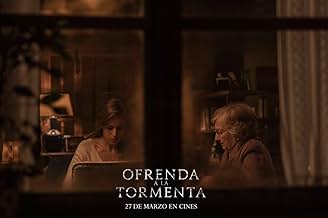AVALIAÇÃO DA IMDb
6,2/10
8,1 mil
SUA AVALIAÇÃO
Em Pamplona, na Espanha, Amaia Salazar é chamada para investigar a morte de uma criança natimorta e a prisão do pai dela. A avó diz que o pai tentou fugir com o corpo do bebê dizendo coisas ... Ler tudoEm Pamplona, na Espanha, Amaia Salazar é chamada para investigar a morte de uma criança natimorta e a prisão do pai dela. A avó diz que o pai tentou fugir com o corpo do bebê dizendo coisas estranhas sobre uma oferenda.Em Pamplona, na Espanha, Amaia Salazar é chamada para investigar a morte de uma criança natimorta e a prisão do pai dela. A avó diz que o pai tentou fugir com o corpo do bebê dizendo coisas estranhas sobre uma oferenda.
- Direção
- Roteiristas
- Artistas
- Prêmios
- 1 vitória no total
- Direção
- Roteiristas
- Elenco e equipe completos
- Produção, bilheteria e muito mais no IMDbPro
Avaliações em destaque
The final installment of the Basque Trilogy, Ofrenda a la Tormenta (Offering to the Storm), is an action-packed, emotionally charged thriller that delivers a satisfying conclusion to the beloved series.
The film picks up shortly after the events of its predecessor, with Inspector Amaia Salazar (Marta Etura) still reeling from the traumatic birth of her son and the loss of her mother. As she struggles to balance her new role as a mother with the demands of her job, a new threat emerges in the form of a serial killer targeting infants.
The killer's MO is gruesome and personal: they kidnap babies and drown them in rivers, mirroring the near-death experience Amaia herself endured as a child, as depicted in the first film. This creates a deeply unsettling atmosphere and adds a layer of personal investment in the case for Amaia, pushing her to her limits both physically and emotionally.
The investigation takes Amaia back to her childhood hometown, where she must confront her own demons and the lingering shadows of her past. The stunning, misty landscapes of the Basque Country provide a haunting backdrop to the film, enhancing the sense of isolation and dread.
The performances in Offering to the Storm are exceptional. Marta Etura delivers a powerful portrayal of a woman grappling with postpartum depression and PTSD while trying to maintain her professional composure. Her vulnerability and strength are palpable, making her one of the most compelling characters in Spanish cinema in recent years.
The supporting cast is equally impressive. Leonardo Sbaraglia returns as psychiatrist Dr. San Martín, providing a calm and compassionate presence amidst the turmoil. Itziar Aizpuru is haunting as the ghostly presence of Amaia's mother, while Pedro Casablanc adds complexity as Amaia's father, whose role in the family's dark history is slowly unveiled.
Director Fernando González Molina masterfully builds tension, employing a mix of tight, intimate shots and sweeping landscape visuals. The film's pacing is relentless, with twists and turns that will keep viewers on the edge of their seats. The action sequences are expertly crafted, showcasing the production's impressive scale and attention to detail.
However, amidst the thrilling set pieces, the film occasionally loses focus on the deeper exploration of its themes. The intricate web of family secrets and the supernatural elements that were so effectively woven into the first two films feel somewhat rushed and underdeveloped here.
While the conclusion provides a sense of closure, it also feels a bit too neat and convenient, wrapping up various storylines in a way that might leave some viewers wanting more complexity. The inclusion of a few new characters, such as a potential love interest for Amaia, also feels unnecessary and takes away from the development of existing relationships.
Despite these minor shortcomings, Offering to the Storm is a gripping and emotionally resonant conclusion to the trilogy. It explores thought-provoking themes of motherhood, trauma, and the enduring impact of childhood experiences, all set against the stunning and evocative backdrop of the Basque Country.
The film picks up shortly after the events of its predecessor, with Inspector Amaia Salazar (Marta Etura) still reeling from the traumatic birth of her son and the loss of her mother. As she struggles to balance her new role as a mother with the demands of her job, a new threat emerges in the form of a serial killer targeting infants.
The killer's MO is gruesome and personal: they kidnap babies and drown them in rivers, mirroring the near-death experience Amaia herself endured as a child, as depicted in the first film. This creates a deeply unsettling atmosphere and adds a layer of personal investment in the case for Amaia, pushing her to her limits both physically and emotionally.
The investigation takes Amaia back to her childhood hometown, where she must confront her own demons and the lingering shadows of her past. The stunning, misty landscapes of the Basque Country provide a haunting backdrop to the film, enhancing the sense of isolation and dread.
The performances in Offering to the Storm are exceptional. Marta Etura delivers a powerful portrayal of a woman grappling with postpartum depression and PTSD while trying to maintain her professional composure. Her vulnerability and strength are palpable, making her one of the most compelling characters in Spanish cinema in recent years.
The supporting cast is equally impressive. Leonardo Sbaraglia returns as psychiatrist Dr. San Martín, providing a calm and compassionate presence amidst the turmoil. Itziar Aizpuru is haunting as the ghostly presence of Amaia's mother, while Pedro Casablanc adds complexity as Amaia's father, whose role in the family's dark history is slowly unveiled.
Director Fernando González Molina masterfully builds tension, employing a mix of tight, intimate shots and sweeping landscape visuals. The film's pacing is relentless, with twists and turns that will keep viewers on the edge of their seats. The action sequences are expertly crafted, showcasing the production's impressive scale and attention to detail.
However, amidst the thrilling set pieces, the film occasionally loses focus on the deeper exploration of its themes. The intricate web of family secrets and the supernatural elements that were so effectively woven into the first two films feel somewhat rushed and underdeveloped here.
While the conclusion provides a sense of closure, it also feels a bit too neat and convenient, wrapping up various storylines in a way that might leave some viewers wanting more complexity. The inclusion of a few new characters, such as a potential love interest for Amaia, also feels unnecessary and takes away from the development of existing relationships.
Despite these minor shortcomings, Offering to the Storm is a gripping and emotionally resonant conclusion to the trilogy. It explores thought-provoking themes of motherhood, trauma, and the enduring impact of childhood experiences, all set against the stunning and evocative backdrop of the Basque Country.
But different than the first movie. More dark and disturbing. Still entertaining and suspenseful.
Do not expect more than that. The first two movies were good, this one is only ok.
It's a pity though... It had a lot of potential.
There's a mess of subplots and side plots so that most of the movie is filler for the central story. 2hrs 20 is a long slog for a pretty simple story if they just stuck to it but they have to drag along so much. Keep in mind also she's a terrible detective who does almost no detective work.
I, like a lot of other folks, are suckers for modern-day detective thrillers especially those from Europe. Nordic noir is one of my favourite genres as well as Asian and American if it's done right. "Offering the Storm", unfortunately, was a weak cloer to its trilogy. Where the heroine was stoic and strong in the first two, here she's just a blubbering mess of emotions, crying when her toenails get stubbed, or crying when a cat falls out of a tree. I'm being facetious, but my goodness, if you're a detective, DEAL with tragedies head on, not whimper like a soulless moron who'd never seen blood before. Other than that, the movie was shot well and filled with ample twists and turns. Recommended? only if you don't mind seeing supposedly strong characters fall flat on their face whenever it rains. smh
Você sabia?
- CuriosidadesAs with previous installments O Guardião Invisível (2017) and Legado nos Ossos (2019), the film was set to premiere theatrically in Spain (on March 27th 2020), followed by a streaming release in other countries through Netflix. However, due to the COVID-19 pandemic, it premiered on Netflix worldwide, including Spain.
- Erros de gravaçãoWhen Amaia goes to retrieve documents and finds that the woman working there has burned them all, she takes a picture of the woman landscape-style with her cell phone. In the next scene, she is talking to another woman and shows her the photo on her phone, but the photo is now portrait-style.
- ConexõesFollows O Guardião Invisível (2017)
Principais escolhas
Faça login para avaliar e ver a lista de recomendações personalizadas
- How long is Offering to the Storm?Fornecido pela Alexa
Detalhes
- Data de lançamento
- Países de origem
- Central de atendimento oficial
- Idiomas
- Também conhecido como
- Offering to the Storm
- Locações de filme
- Elizondo, Navarra, Espanha(Amaia's home town, scenes on the bridge)
- Empresas de produção
- Consulte mais créditos da empresa na IMDbPro
- Tempo de duração2 horas 19 minutos
- Cor
- Proporção
- 2.35 : 1
Contribua para esta página
Sugerir uma alteração ou adicionar conteúdo ausente

Principal brecha
By what name was Oferenda à Tempestade (2020) officially released in India in Hindi?
Responda
![Assistir a Tráiler [OV]](https://m.media-amazon.com/images/M/MV5BYzM1MDRiYzEtODJlNC00ZGFhLWJlOTEtOTU1NDFiMDJhZmZlXkEyXkFqcGdeQXRyYW5zY29kZS13b3JrZmxvdw@@._V1_QL75_UX500_CR0)



































